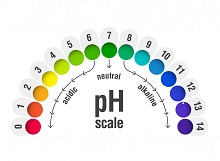PH: Definition and measurement units
PH is a measure of how acidic/basic water is. The range goes from 0 to 14, with 7 being neutral. pHs of less than 7 indicate acidity, whereas a pH of greater than 7 indicates a base. pH is really a measure of the relative amount of free hydrogen and hydroxyl ions in the water. Water that has more free hydrogen ions is acidic, whereas water that has more free hydroxyl ions is basic. Since pH can be affected by chemicals in the water, pH is an important indicator of water that is changing chemically. pH is reported in “logarithmic units”. Each number represents a 10-fold change in the acidity/basicness of the water. Water with a pH of five is ten times more acidic than water having a pH of six.
Importance of pH
The pH of water determines the solubility (amount that can be dissolved in the water) and biological availability (amount that can be utilized by aquatic life) of chemical constituents such as nutrients (phosphorus, nitrogen, and carbon) and heavy metals (lead, copper, cadmium, etc.). For example, in addition to affecting how much and what form of phosphorus is most abundant in the water, pH also determines whether aquatic life can use it. In the case of heavy metals, the degree to which they are soluble determines their toxicity. Metals tend to be more toxic at lower pH because they are more soluble. (Source: A Citizen’s Guide to Understanding and Monitoring Lakes and Streams)
Diagram of pH
As this diagram shows, pH ranges from 0 to 14, with 7 being neutral. pHs less than 7 are acidic while pHs greater than 7 are alkaline (basic). Normal rainfall has a pH of about 5.6—slightly acidic due to carbon dioxide gas from the atmosphere. You can see that acid rain can be very acidic, and it can affect the environment in a negative way.
Measuring pH
The U.S. Geological Survey analyzes hundreds of thousands of water samples every year.  Many measurements are made right at the field site, and many more are made on water samples back at the lab. pH is an important water measurement, which is often measured both at the sampling site and in the lab. There are large and small models of pH meters. Portable models are available to take out in the field and larger models, such as this one, are used in the lab.
Many measurements are made right at the field site, and many more are made on water samples back at the lab. pH is an important water measurement, which is often measured both at the sampling site and in the lab. There are large and small models of pH meters. Portable models are available to take out in the field and larger models, such as this one, are used in the lab.
To use the pH meter in the photograph below, the water sample is placed in the cup and the glass probe at the end of the retractable arm is placed in the water. Inside the thin glass bulb at the end of the probe there are two electrodes that measure voltage. One electrode is contained in a liquid that has a fixed acidity, or pH. The other electrode responds to the acidity of the water sample. A voltmeter in the probe measures the difference between the voltages of the two electrodes. The meter then translates the voltage difference into pH and displays it on the little screen on the main box.
Before taking a pH measurement, the meter must be “calibrated.” The probe is immersed in a solution that has a known pH, such as pure water with a neutral pH of 7.0. The knobs on the box are used to adjust the displayed pH value to the known pH of the solution, thus calibrating the meter.
Checking pH at home or school
One of the most popular school science projects is to take the pH of water from different sources. Chances are your school (and certainly not you) does not have an electronic pH meter lying around, but you can still get an estimate of pH by using litmus paper. Litmus paper, which can be found at pet-supply stores (to check the pH of aquariums) is simply a strip of paper that, when a sample of water is dropped onto it, turns a certain color, giving a rough estimate of pH.












